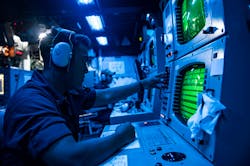Lockheed Martin eyes Integrated Common Processor (ICP) for bistatic sonar and anti-submarine warfare (ASW)
SAN DIEGO – Undersea surveillance experts at Lockheed Martin Corp. are enhancing technology to detect, classify, and track quiet enemy diesel attack submarines in shallow coastal waters.
Officials of the Naval Information Warfare Systems Command (NAVWAR) in San Diego have announced an $63.6 million sole-source order on 3 Sept. to the Lockheed Martin Rotary and Mission Systems segment in Manassas, Va., for the Integrated Common Processor (ICP) program.
The ICP program provides a common Integrated Undersea Surveillance Systems (IUSS) signal processing and display system software and hardware suite for Surveillance Towed Array Sensor System (SURTASS) ships and IUSS shore sites.The ICP is a component of the Navy's Maritime Surveillance Systems (MSS) system of fixed, mobile, and deployable acoustic arrays that help detect, localize, and track quiet diesel and nuclear submarines.
Related: Lockheed Martin provides signal processing for global anti-submarine sonar
The IUSS is a large-area ocean basin surveillance system to track surface ships and submarines over large swaths of the world's oceans. It consists of fixed fields of hydrophones and sonar sensors such as the Sound Surveillance System (SOSUS) and Fixed Distributed System (FDS); the Advanced Deployable System (ADS) relocatable sonar sensor field; the Surveillance Towed-Array Sensor System (SURTASS) aboard long-endurance surveillance ships; and the Surveillance Direction System (SDS) that provides command, control, communications, and data fusion to combine the capabilities of SOSUS, FDS, and SURTASS.Navy anti-submarine warfare (ASW) experts are fine-tuning MSS technology to be effective against modern diesel and nuclear submarines in regional, littoral, and broad ocean areas of interest. That's where the ICP program comes in.
ICP is developing the capability to process and display data from all fixed and mobile underwater systems to take advantage of automation advancement, array technology improvements, hardware insertions, and the common software components of the submarine and surface undersea warfare systems.
Eventually the ICP program is intended to provide processing power to support the Navy's low-frequency active (LFA) ASW bistatic sonar processing using the Lockheed Martin Twin-line 29A towed-array sonar for SURTASS submarine-hunting ships.
Related: Lockheed Martin to upgrade sonar signal processing computers for Navy undersea surveillance
To optimize sonar signal-processing power and keep costs as affordable as possible, the ICP is capitalizing on the Navy's Acoustics-Rapid COTS Insertion (A-RCI) program, which uses the latest generations of commercially available computer server technology for sonar signal processing aboard Navy submarines and surface vessels.
The ICP will have the capability to process and display data from all fixed and mobile underwater systems, and will be used for all new system installations and replace the legacy systems as they reach end of life and require upgrading.
Since 2011 Lockheed Martin engineers have been developing automation algorithms and techniques for addressing multi-array high beam count requirements in the ICP program, and have continued with sonar signal processing upgrades in coordination with the Submarine A-RCI program.
On this contract Lockheed Martin will do the work in Manassas, Va., and should be finished by December 2022. For more information contact Lockheed Martin Rotary and Mission Systems online at www.lockheedmartin.com, or NAVWAR at www.navwar.navy.mil.
About the Author
John Keller
Editor-in-Chief
John Keller is the Editor-in-Chief, Military & Aerospace Electronics Magazine--provides extensive coverage and analysis of enabling electronics and optoelectronic technologies in military, space and commercial aviation applications. John has been a member of the Military & Aerospace Electronics staff since 1989 and chief editor since 1995.
